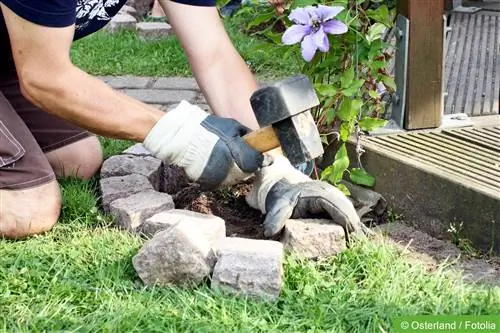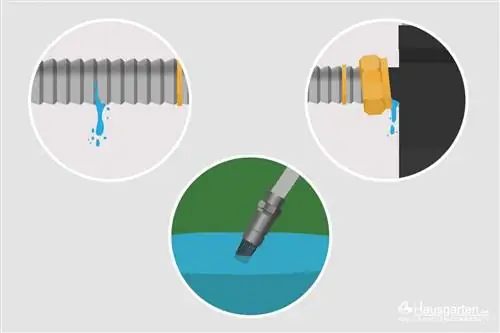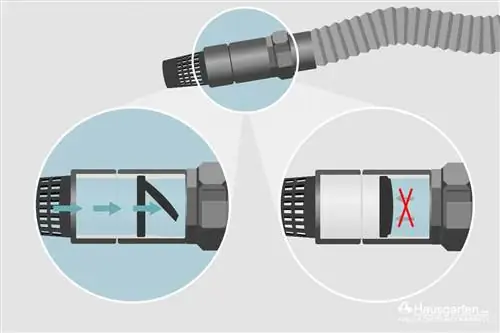- Author admin [email protected].
- Public 2023-12-17 03:39.
- Last modified 2025-01-24 12:45.
A beautiful garden also includes paved paths. Whether curved or straight, made of simple exposed concrete or beautiful bas alt heads, they not only help you get through the garden with dry feet, but also set visual accents.
Who hasn't looked enviously at a garden with a beautiful, paved path? Because craftsmen are expensive and having a path paved can quickly cost thousands if you outsource the job. You can also do paving work yourself. In this article you will find out what you need to consider when building paving, what materials you need and what costs you should expect.
Paving work: before you start, go to the hardware store
You don't have to buy everything you need to pave your patio or path right away. Most machines and tools can be rented from hardware stores or construction equipment dealers. What you absolutely need to create a path:
- Bucket, spade, shovel, rake, tools that every garden owner has anyway
- a wheelbarrow
- Spirit level and squeegee
- Shaker or rammer (borrow from hardware store)
- Stone cutter
- Rubber hammer (for tapping the stones into place, other hammers would leave marks)
- Concrete
- and of course: sand or gravel and stones or concrete slabs! (more on the quantities later)
Hey ho, hey ho
Exactly, the work song of the 7 dwarves who go into the mountain armed with pickaxes. You don't have to dig that deep to create your path. But you do have to do a bit of civil engineering. Before digging, mark the exact path with a piece of string. Depending on the use of the path, an appropriate substructure must be installed. If it is just a sidewalk, 15-20 cm of gravel under the stones is sufficient. If the path is to be used, it has to be 30-40 cm. Accordingly, the terrain must be excavated to a depth beforehand. An addition depending on the thickness of the stones goes without saying. When paving terraces and driveways, please note that a slight slope in the paving prevents flooding in the adjacent living room or on the path. It can be 5% inclination.
Step by step, stone by stone
What happens then? Start the paving work like a puzzle: at the edge. First, place the curbs on the path so that they are level with the ground. To ensure that nothing slips, the curbs are set in a sand-cement mixture. Use a guideline and spirit level to insert the stones. Correction can only be made as long as the concrete has not yet hardened. So if possible, check every stone to see whether it is sitting where it should be. Avoid gaps between curbs.
Now it's time for the first layer of gravel: it should be 15-20 cm, pull it smooth and shake it down. Shaking is not always done, but it prevents the pavement from sagging the next time it rains. If you work carefully when building paving, it saves a lot of work afterwards. Otherwise, sagging plasters will have to be picked up and re-laid. The laying sand is then placed on the first layer of gravel. This is smoothed out again and then compacted.
The stones or slabs are now finally inserted into the laying sand. With slabs, the paving work is quite easy. First align the plate at the edge and tap it into place with a rubber mallet. Lay out row by row, staggered, like with laminate. This means you don't have to work in joints and the look doesn't suffer from long joints.
Paving stones can be challenging. If you have chosen an extravagant pattern, the paving work must also be aligned according to this. Stars or crosses in particular can be a real challenge. Of course, it's easier with plain stones without a pattern. Like the plates, they can be staggered in rows, which also creates a nice, even pattern.
If everything is where it should be, it will be shaken again. The stones sink approximately 2 cm deep into the ground. So that the joints between the panels are filled, fine-grained sand is first swept in, then slurried in (that's right, missing from the list above, watering can or water hose). Make sure that the sand is washed in and not washed out again.
And how much does self-paving cost?
Let's assume, as ambitious laypeople, that we want to build a small path 5 meters long from the house to the garden pavilion. This should be 1 m wide as no oncoming traffic is expected here. So the sample calculation (without guarantee) for 1 m x 5 m=5 sqm:
- for the first layer of gravel: 5sqm x 0.15m=0.75 cubic meters
- for the laying sand: 5sqm x 0.05m=0.25 cubic meters
Edges: are of course available in different designs; at 1 meter length 5 per side, so a total of 10 pieces
Paving: depending on the thickness of the curbs, with a thickness of 8 cm there is still 84 cm of the path left, so: 5m x 0.84 m=4.2 sqm, Just like when laying tiles, please allow for some waste.
Provide the whole thing with current prices
- Gravel, grain size 0/32, 0.75 cubic meters ~ 1.2 t=approx. 7 euros
- Laying sand, grain size 0/5 ~0.38 t=approx. 3 euros
- Mud sand: approx. 4 euros
- Paving stones: rectangular paving, brown, 11.75 euros/sqm for 4.5 sqm=53 euros
- Curbs: per piece. 2-3 euros=20-30 euros for the journey
- Bag of garden and landscaping concrete: 6.75 euros
Total makes about 105 euros for the material. In addition, there are the rental prices for vibrators and other tools. Good for those who have a trailer and a gravel pit at their disposal, because the delivery fees for these quantities are disproportionate to the price of the material.
If you haven't yet gotten the courage to build paving, you can now calculate what you need for your paving work. The others should be told that paving is not as difficult as it may sound here and there. But of course there are specialists who would be happy to take care of your paving work.
Craftsman prices for paving work
Basically, when calculating the costs of paving work or paving construction, it depends on whether only the pure working time is billed or whether the company also provides the material and of course also calculates it. The craftsmen's prices are 16 to 20 euros per square meter for laying natural stones and small paving stones. When laying concrete blocks, you can expect a price of six to 12 euros. This only includes the pure price of the installation, without the material. In addition, the substructure for the work including materials usually costs 200 to 350 euros. In addition to these costs, there is of course the price of the materials. Simple concrete blocks, for example, cost between 8 and 20 euros per square meter, high-quality concrete blocks cost 17 to 32 euros.
Concrete stone is considered an industrial mass product in the lower price segment if the pure production costs are taken into account. However, high-density cast stone is not that inexpensive and is sometimes even higher than the price of natural stone.
The costs for natural stones depend, among other things, on the format, the extraction and processing ability and, in particular, the skill of the seller. The disadvantage of the natural stone market is the lack of transparency, because quality cannot be derived from the price of a natural stone. The technical data must therefore be examined individually, taking into account the requirements profile and personal taste. The costs for natural stones for paving construction vary between 14 and 80 euros per square meter.
It is important to look at what work will be carried out in detail when making a cost estimate. High prices often result in services for all edging variants such as edging stones, curbs, base lines and natural stone edging.
Additional surface unsealing
Some craft businesses offer surface unsealing. A distinction is made between two paving variants: open-pored paving stones and open-joint paving stones. Through the stone or through the joints, the resulting rainwater can be returned to the natural water cycle. The costs for these stones and the type of laying are usually significantly higher than for a conventional paving, which is due to the special demands on the base layer and the paving material. However, such an investment in paving construction or paving work usually pays for itself in just a few years through savings on wastewater fees.






